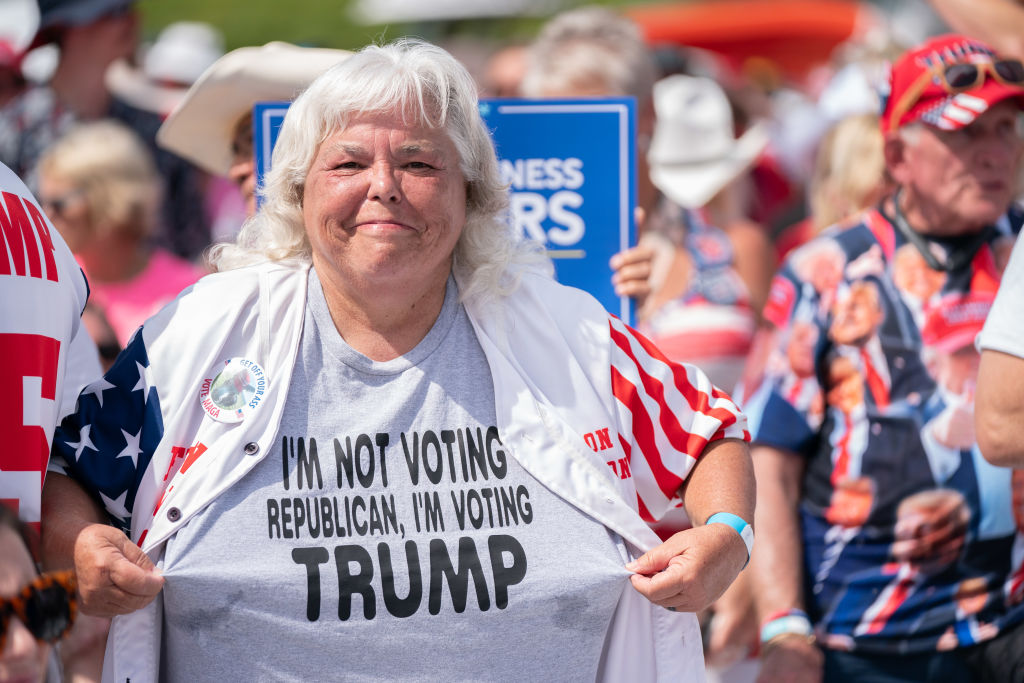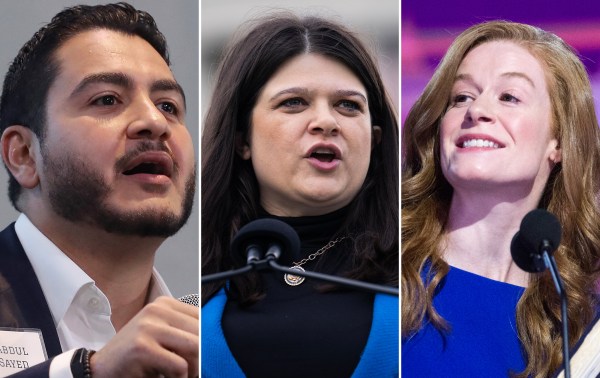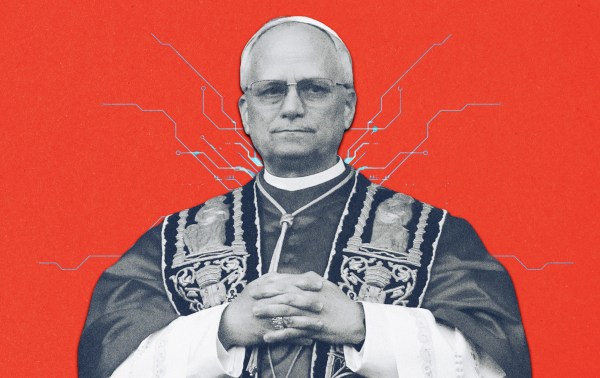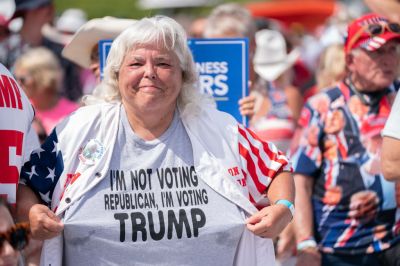When we talk about America's political parties today, there seem to be just two: Democrats and Republicans. This is all the more amazing given widespread dissatisfaction among voters, a majority of whom don't want to see a Trump-Biden rematch in 2024. Yet most analysts still claim that a third-party run is simply impossible and that Americans are destined to be held hostage by the two feuding parties.
But this is a narrow view of U.S. history. In fact, over the past 225 years, there have been a host of parties (and third parties), including: the Federalists, the Whigs, the Greenback Party, the Know-Nothing Party, the Liberty Party, the Free-Soil Party, the Anti-Masonic Party, the Bull Moose/Progressive Party, the Independent Party, and the National Republican Party. Some have had brief tenures, some longer, but the fact that we have had so many speaks to the possibility that America might not be a Republican or Democrat duopoly forever.
Parties fall because of internal contradictions that prevent them from confronting external events. The Federalists were never able to build support outside the Northeast in the aftermath of the War of 1812. The Whigs, in contrast, could not reconcile the conflict between Northern and Southern party members over slavery. In other words, the Whigs could not sustain being a national party with internal contradictions, while the Federalists could not overcome being a regional party.
Other parties rose to tackle a national issue that had been insufficiently addressed by the other two parties. The Know Nothings were anti-immigration, for example; the Anti-Masonic Party was, as the name suggests, anti-Mason; and Ross Perot secured 19 percent of the popular vote, but zero electoral votes, with his message about our unsustainable debt—about $4 trillion at the time, roughly an eighth of what it is today.
What might this history mean for Democrats and Republicans today? We’ve certainly had our share of national tumult in the short two decades of the 21st century, starting with the 9/11 attacks, continuing with the 2008 financial collapse, and most recently the COVID pandemic. And we also face the threat of other potential external shake-ups, be it war with increasingly belligerent adversaries or a financial collapse based on our massive and growing debt.
While there is a possibility of these external events shaking up our parties, it is not a certainty. The parties have survived the tumultuous 21st century thus far, albeit in a weakened state. This weakening has multiple causes, including the McCain-Feingold financing rules that diminished their fundraising power and the rise of social media platforms that allowed individual politicians to develop their own communications apparatuses outside of the parties’ superstructures.
In a duopoly, though, even weak parties are hard to supplant. What is far more common, and probably more likely, is continued realignment. The truth is that the Democrats and Republicans do change regularly, both in position and in the nature of their supporters. Black voters, for example, were solid Republicans for almost a century after the Civil War, but they have been solid Democrats for the half-century since. Southern whites moved as well. When Lyndon Johnson passed the Civil Rights Act of 1964, he told aide Bill Moyers, “Well, I think we may have lost the South for your lifetime—and mine.”
Southern GOP dominance has gone on for even longer than Johnson predicted. However, we are now seeing cracks in that foundation, with North Carolina and Georgia becoming increasingly purple in recent elections.
The Catholic vote was once seen as something that politicians could win or lose, but now Catholics pretty much vote as the country does. Democrats were once the pro-Israel party. Now, Republicans are seen as more pro-Israel. As the demographics of the party shift, so does their issue mix.
The biggest disruptions within the parties take place as a result of the quadrennial presidential primary process. Whoever takes over the party by winning the primaries puts his or her stamp on it. If they win the general election, the stamp gets darker and deeper. If they win reelection, they can define their party for a decade or even a generation. We have seen this phenomenon take place multiple times over the last century. Franklin Delano Roosevelt created an unwieldy but powerful coalition of rural whites, labor, urban ethnics, and enough blacks to win the presidency four times. Dwight Eisenhower did well with both blacks and upper-class whites. John F. Kennedy wrested the black vote from the Republicans in part by calling Martin Luther King’s wife while King was languishing in prison. Ronald Reagan’s coalition brought formerly Democratic urban ethnics over to the Republicans with an issue mix that included tax cuts, a strong stance on crime, and opposition to the Soviet Union. Republicans successfully wielded those issues for a generation, but those issues lost their resonance in the 1990s—and since then Republicans have won the popular vote for the presidency only once.
Today, both parties struggle with unpopular standard bearers who nevertheless appear likely to win their respective nominations once again. Republican struggles with Trump have been quite clear through four consecutive election defeats—the 2018 midterms, the 2020 presidential election, the 2020 Georgia Senate sweep, and the disappointing 2022 midterms. Trump has indeed brought a different demographic look to the Republican Party, attracting high percentages of rural and lower-educated whites as well as Hispanics, while driving college-educated voters into the arms of the Democratic Party. In addition, his issue mix is not always clear, as it seems so dependent on his own particular whims and preferences of the time. One of the reasons his White House was so fractious was that there were three groups that could all plausibly claim to be representing the true Trump: the MAGA-ites like Steve Bannon and Stephen Miller; the traditional Republicans like Larry Kudlow and Reince Priebus; and the globalists, like Gary Cohn, Jared Kushner, and Ivanka Trump.
Trump was well aware of these fault lines. That’s why in 2020 he did not allow an official GOP platform, so that he and the party could not be pinned down on specific issues. Although the Republican Party does still seem to favor Trump, it’s quite clear that his bundle of issues may change again—and it is entirely possible he will alter course on an issue that fragments his supporters. What’s inarguable is that when he exits the stage, the GOP will have to reestablish what principles will guide its policies in the future.
As for the Democrats, they may have even greater challenges ahead after Biden leaves national politics. He successfully held the Democratic coalition together in 2020, running mainly as an anti-Trump candidate. Going forward, though, the Democrats face a host of serious internal contradictions that will be made more apparent once Trump is no longer their bete noire. Do they want to be the party of the woke, which drives away middle America and non-elite voters, or do they want to do a Bill Clinton and engage moderate voters, thereby risking denunciation by the loud woke voices in the party and the media?
When I served in the George W. Bush administration, his constant refrain was that he was fighting against the forces of nativism, isolationism, and protectionism. Trump-supporting Republicans certainly do not speak that way today, but it was only 15 years ago that Bush was the party head and largely popular with Republican voters. These things can change rapidly, especially in the aftermath of a contested primary in which a new face or voice emerges as the party head. All the people who are talking about a new party emerging are correct in this way: The parties are likely to change a great deal in the course of the 2020s. It’s just that their names will most likely still be the Democratic and Republican parties.






Please note that we at The Dispatch hold ourselves, our work, and our commenters to a higher standard than other places on the internet. We welcome comments that foster genuine debate or discussion—including comments critical of us or our work—but responses that include ad hominem attacks on fellow Dispatch members or are intended to stoke fear and anger may be moderated.
With your membership, you only have the ability to comment on The Morning Dispatch articles. Consider upgrading to join the conversation everywhere.